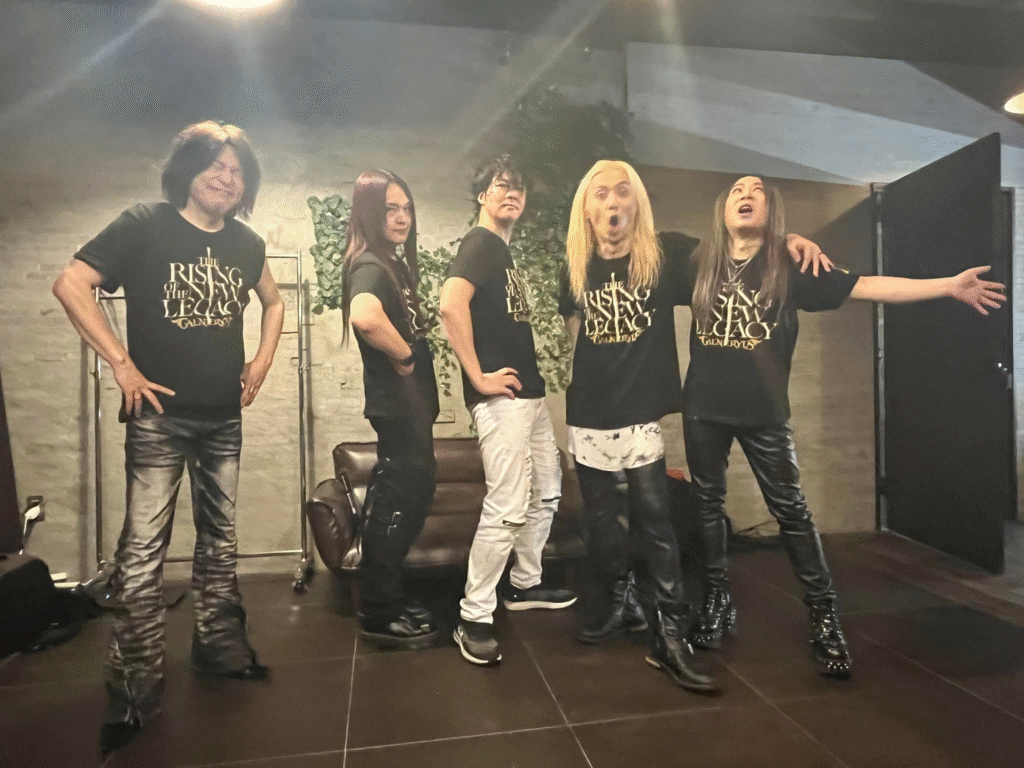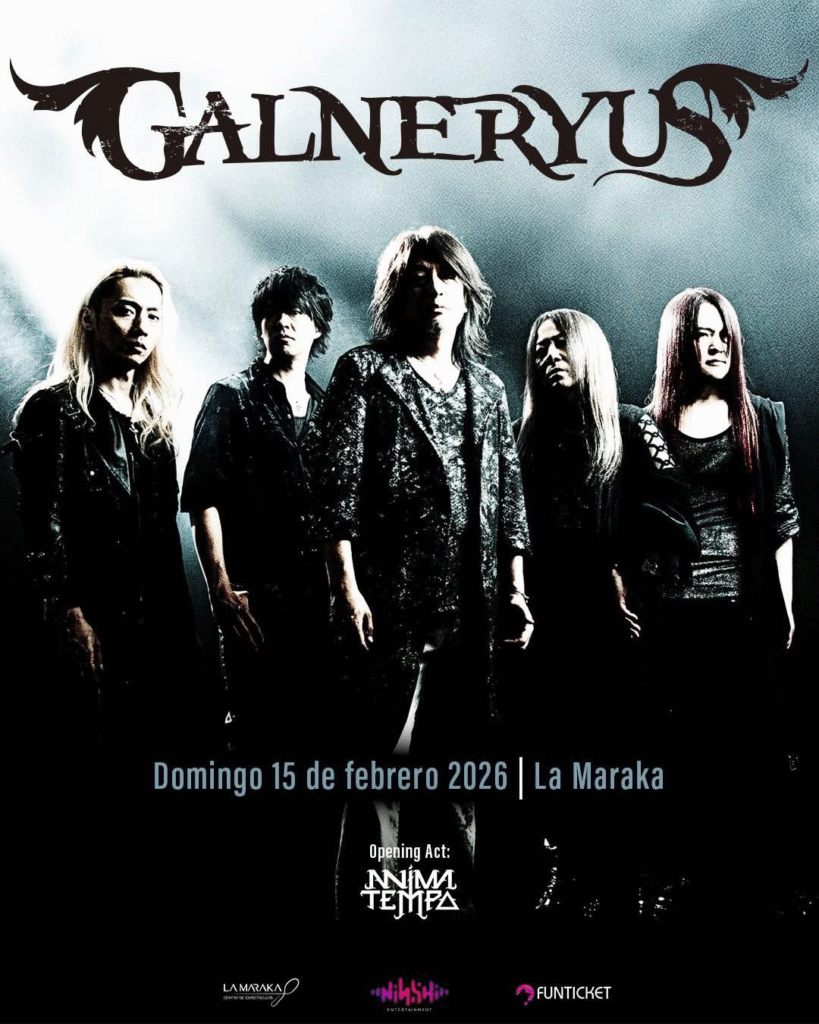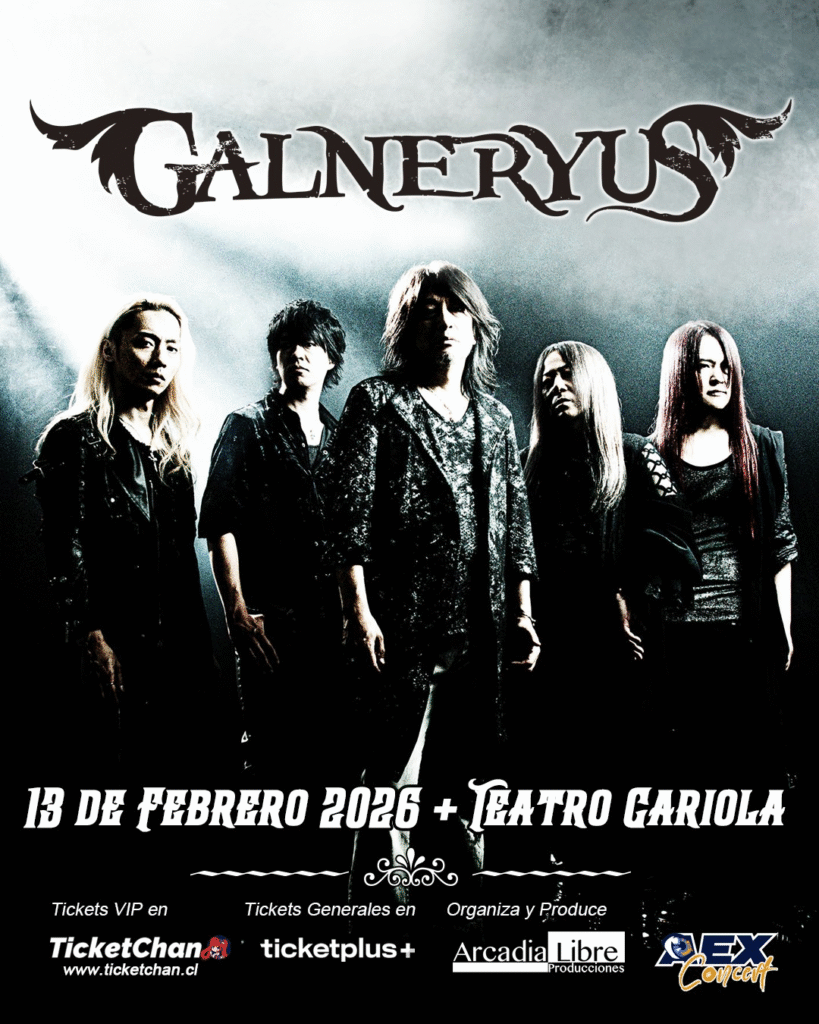For more than two decades since their formation in Osaka, GALNERYUS has solidified their place as one of the undisputed pillars of modern Japanese metal. Their fusion of neoclassical virtuosity, melodic sensitivity, and unmistakable epic storytelling made them a global reference long before Japanese metal began expanding forcefully into Europe and Latin America. Today, with a lineup that is more cohesive and creatively driven than ever, the band stands in a moment of artistic maturity that allows them to look back with pride—and forward with renewed hunger.
In February 2026, the group will return to Mexico to reunite with one of the most passionate audiences of their recent career, a crowd whose fervor left an indelible mark on their previous visit. In this context, we spoke with GALNERYUS about their history, evolution, the pillars of their sonic identity, and the role they have played in projecting Japanese metal onto the international stage. The result is an intimate and insightful portrait of a band that, without losing its essence, continues raising its own creative bar while looking toward the future with determination.
Here is GALNERYUS in their own words.
Looking back at your formation in Osaka in 2001, was there any moment or internal conflict that made you realize you should aim for a global vision beyond the local scene?
From the very beginning, GALNERYUS wanted people not only in Japan but around the world to listen to our music. We had no internal conflict about it, but since the internet wasn’t widely used back then, promoting ourselves was more difficult than it is today.
Your sound blends neoclassical, symphonic, and power metal. What musical, aesthetic, and philosophical influences shaped your early identity?
Regarding the songs I compose, I grew up with classical music, so I cherish that sensibility when writing. I’ve been strongly influenced by X JAPAN, Yngwie Malmsteen, DREAM THEATER, STRATOVARIUS, and I also draw inspiration from J-POP.
You're considered one of the most influential bands in modern Japanese metal. How has the scene evolved since your debut, and what creative decisions of yours do you feel contributed to that evolution?
Japan has many amazing metal bands, and we do see some groups influenced by GALNERYUS, which makes us very happy. If our music truly inspires others, nothing could make us prouder.
With the spread of the internet, many “cover” players and singers have emerged today—this is very different from the past. It’s wonderful that people can now access so much music so easily.

When you moved to Warner Music Japan in 2017, how did that new corporate and international environment influence your creative process and the balance between evolution and identity?
We moved together with the producer and A&R who had supported us since the VAP era, so in a good way, not much changed.
Your 2024 album THE STARS WILL LIGHT THE WAY comes after more than 20 years of career. What artistic legacy did you want to capture, and how did you define your next step?
Since many songs were written during our tour, the album contains tracks designed to excite the live audience. Although it's the 20th anniversary album, we didn’t overthink that aspect—we simply wanted to make a very melodic record. We are already working on the next one, which will likely include more complex musical developments.
Regarding the album’s concept and your 20th anniversary, how did each member approach their musical values, and how does the title reflect the band’s mindset?
THE STARS WILL LIGHT THE WAY carries a strong meaning: we take the many tragic events happening worldwide very seriously, but we want to move forward believing that the future will shine bright. Each member recorded with that feeling in mind.
With the current lineup (Syu, Sho, Taka, Yuhki, Lea), how have you maintained the internal dynamics necessary to preserve the band’s identity while staying creative?
The current lineup is the most creative we’ve ever had, and we communicate extremely well. Above all, we get along wonderfully, which is just amazing.
Everyone expresses what needs to be said and fulfills their role properly. This balance feels almost miraculous.

What role do you think GALNERYUS has played in expanding Japanese metal worldwide, especially in Europe and Latin America?
Our music is melodic, classical, and contains progressive elements, but the most important part is the beauty of the vocal melodies. If listeners appreciate that, we’re very happy. We also hope GALNERYUS becomes a gateway for discovering other great Japanese metal bands.
Your upcoming concert in Mexico at La Maraka on February 15, 2026 reunites you with very passionate fans. What memories from previous Mexican shows influence your preparation for this return?
When we performed in Mexico last time, we were deeply moved by the enthusiasm of the audience. We immediately felt how much they loved our music. That powerful emotion remains with us today. We’re incredibly grateful and excited to see everyone again, so we’ll prepare a lot!
For the Mexico and Latin America setlist, how do you balance classics like “HUNTING FOR YOUR DREAM,” mid-era songs, and tracks from the new album?
We’re still deciding the setlist, but we believe we shouldn’t leave out the songs fans most want to hear.
Technical mastery is central to your music. How do you balance that with emotional communication that reaches diverse audiences?
echnique is very important to us, and we enjoy the challenge it brings. But we believe that once technique becomes second nature, we must go beyond it to reach emotional expression. That’s why we practice consistently.
Your style blends Japanese elements with European power metal. Where is that fusion most evident—lyrics, harmonies, or production?
It’s most evident in the vocal melodies, followed by the melodic arrangements in the instrumental sections.
After the 2024 album, have new directions begun to emerge—bolder concept works, international collaborations, or expanded Latin American tours?
We’re now traveling abroad more often than before, which makes us very happy. It’s wonderful that so many people overseas listen to our music. We want to create even better works to reach more listeners. We’ve thought about concept albums, but right now we’re more focused on creating “dramas within each song.”
As one of Japan’s leading metal bands, what advice would you give new groups seeking international success without losing their local identity?
They should value their individuality and highlight it—even in extreme ways. I’ve always disliked the idea of being seen as “just one more similar band,” so I constantly tried to stand out by doing something different.
From THE FLAG OF PUNISHMENT (2003) to now, what moments—albums, lineup changes, tours, creative decisions—were decisive for shaping your identity?
Tenemos un profundo cariño por todos nuestros álbumes, pero Resurrection marcó un punto especial: fue cuando Ono y TAKA se unieron, y con la calidad del disco, la valoración del público aumentó mucho. Ese álbum definió el estilo musical que mantenemos hasta hoy.
Otro disco especialmente significativo es UNDER THE FORCE OF COURAGE: es un álbum conceptual y sentimos que hicimos el mejor metal que podíamos crear.
We cherish all our albums, but Resurrection holds special meaning: it marked the addition of Ono and TAKA, and its quality elevated our reputation, giving us confidence. It defined the musical style that continues today. Another deeply meaningful album is UNDER THE FORCE OF COURAGE—a concept work in which we created the best metal we could.









